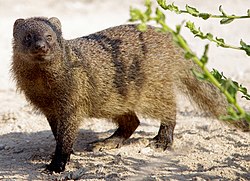
In medieval literature, the ichneumon or echinemon was the enemy of the dragon. [1] When it sees a dragon, the ichneumon covers itself with mud, and closing its nostrils with its tail, attacks and kills the dragon. The ichneumon was also considered by some to be the enemy of the crocodile and the asp, and attacks them in the same way. The name was used for the pharaoh's rat, mongoose, or Egyptian mongoose (Herpestes ichneumon), which attacks snakes; it can also mean otter . The ichneumon is shaped similarly to a ferret, although much slimmer in its shape, and the head is elongated. Also, it is an animal that can move swiftly and is able to jump a couple of yards with a single leap. [2]